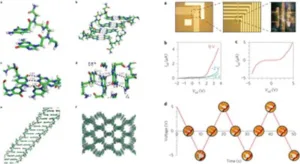In an article published in Nature Nanotechnology, researchers from the University of Tel Aviv announced that they have found a material class that is not only self assembling but also electroluminescent. According to the publication, Prof. Ehud Gazit and doctoral student Or Berger of the Department of Molecular Microbiology and Biotechnology at TAU, in collaboration with Dr. Yuval Ebenstein and Prof. Fernando Patolsky of the Raymond and Beverly Sackler School of Chemistry at TAU, developed and characterized a set of materials that could become the basis for growing fully flexible electronic displays.
The basis for this material lies in the reproducibility and self assembly functionality of DNA, which is the basis of all life on earth. The researchers synthesized peptides and tested their ability to self assemble into crystal structures.
TAU Electroluminescent Peptides (left: crystallized structure and right: electroluminescent FET structure)
As shown in the above image, the group successfully created crystallized structures in some of the synthesized peptides. The peptides are peptide nucleic acids (PNAs), which mimic short DNA strands that form repeatable structures. To the surprise of the researchers, the resulting structures showed not only self fluorescence, but also responded to an applied voltage. This makes them an organic light emitting structure.
Since the effect stems from a thin layer of molecules, the resulting structure will be very flexible. In addition, the resulting structures are fully recyclable. A perfect solution for electronic displays it seems.
Analyst Comment
This kind of technology comes as a little surprise. While both functionalities (self assembly and electroluminescent materials) already exist today in the form of all biological life and OLED displays, the combination opens a complete new approach to electronic displays. In reality this kind of technology is about as far from bringing OLED displays to market as the discovery of electroluminescence in organic materials in the 1950’s. While it may not take 60 years for this effect to make in-roads into the display industry, there is still a whole lot to learn about the underlying science before we can start thinking about actual devices.
Nevertheless, the idea of using self assembly to create display structures is very intriguing. It would change the complete approach to making displays. Instead of semiconductor factories we may see chemistry labs growing a display to specification. Resolution may not be an issue at all to create small electroluminescent structures, which is still limiting OLED fabrication for now. There is no information on light output, life time and other very important characteristics, and there are certain to be some very high hurdles for this technology on the way to commercialization, as it was true for every other display technology we use today. This technology may give the idea of “life like” images a complete new meaning though. – NH

